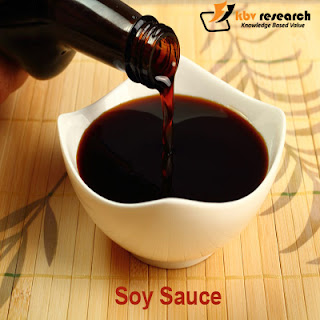Soy Sauce Market: The History, Present, and the Future
Practically, there are hundreds
of varieties of soy sauce.
Varieties that rely on the ingredients used, the process used to make the
sauce, and the region where it is made. A few major varieties can be found in
grocery stores or listed in recipes: low sodium, light, dark, and tamari.
Innovations in food production
have resulted in a quicker, less expensive method of soy sauce production that
uses acid-hydrolyzed protein from vegetables. This method requires just a few
days and provides a product that is more compatible with a longer shelf life.
That being said, this method has been rejected by traditionalists as it does
not create the flavor depth found with the traditional brewing method.
What are soy sauces?
Soy sauce is among the oldest
condiments in the world that have been used for over 2,500 years in China. A
mixture of mashed soybeans, salt, and enzymes is made from fermentation. It is
also produced by a chemical process known as acid hydrolysis.
To ensure that the finished sauce
fulfills minimum quality requirements, numerous analytical tests are carried
out. There are several recommended requirements, for example, in brewed sauces.
The total salt should be 13-16% of the final product; the pH level should be
4.6-5.2; and 6% of the total sugar content. There is an average of 42%
hydrolyzed protein for the non-brewed type; maize syrup should be less than 10%
and Carmel color 1-3%.
History
Soy sauce has a rich and
delightful history of use in many delicacies, primarily in China, Korea, Japan,
Vietnam, Burma, Thailand, Indonesia, and the Philippines, like many other soy
foods. As early as the 1st century AD in China, the Chinese character
"sho" appeared in recipes, referring to a fermented food made either
from vegetables or preferably from flesh or fish.
Possibly, this "sauce"
was not served in the form of a drink, but rather in the form of an unrefined
paste, during the initial periods of soy sauce consumption. In Japanese
cuisine, the term "moromi" has often been used to refer to this early
paste-like type of soy sauce. Currently, this paste-like form of soy would
often simply be identified as "miso." It may have taken around
500-1,000 years for soy sauce to become prevalent in the form of a true liquid.
What's New and Beneficial About Soy Sauce?
·
Digestive
tract benefits
Recent studies show that soy
sauce may provide benefits for the digestive tract. Such benefits relate to the
process of soy sauce fermentation and the synthesis during this phase of certain
special carbohydrates (known as oligosaccharides). Some of the micro-organisms
involved in the fermentation of soy sauce include enzymes that can break apart
special soybean fibers (hemicelluloses). When these hemicelluloses are broken
apart, oligosaccharides are formed and these oligosaccharides can aid in our
large intestine to promote the growth of "good" bacteria.
Soy sauce is widely considered to
be a salty food, and this assumption is correct as it is not uncommon for a
tablespoon of soy sauce to contain 1,000 milligrams of sodium. In this sense,
'salt' and 'sodium' can be used interchangeably because table salt consists of
sodium and chloride; it is the sodium component involved in health problems in
salt-sensitive individuals. It is valid that 1,000 milligrams of sodium is a
large amount and it is also about half of the recommended sodium intake limit
throughout a day.
·
Over the
period, it has become less allergenic
Since soybeans are amongst the
eight types of food most often associated with a food allergy, many people
believe soy sauce is a food of greater than the normal potential to cause
allergy issues. New research on the subject, however, indicates that soy sauce
can be a much less allergic-type of soy that can support the immune and inflammatory
systems, usually involved in an allergic response.
In this new research, two
variables are particularly fascinating. First is the breakdown during the soy
sauce fermentation process of essential allergy-triggering proteins in
soybeans. The second factor is the benefits of the immune and inflammatory
system provided by special polysaccharides in soy sauce. Some of these family
carbohydrate molecules may decrease an enzyme's activity called hyaluronidase.
This enzyme's over activity is linked to increased inflammation as well as
increased risk of an allergic reaction. Soy sauce polysaccharides can reduce
the risk of an allergic reaction by reducing its activity.
Industry Insights: How have the market giants been strategizing to make it better?
Lee Kum Kee is a Hong Kong-based
food company that specializes in manufacturing a wide range of Chinese and
Asian sauces. In November of 2018, the company launched a light soy sauce and
panda oyster sauce for expanding its business reach to gluten-free substitutes.
The company had introduced these sauces for customers that prefer gluten-free
due to their changing lifestyle. In 2019, the company further launched a brand
new line of Panda Brand Grilling and Dipping Sauces. Keeping in mind the
customer preferences, the sauces range included authentic, restaurant-quality
soy sauce, condiments, oils, stir-fry, and marinade sauces.
The Future
The future of the soy sauce market
is forever changing as breakthroughs are made in food technology. Upgraded
processing techniques have already encouraged the development of customized
types of soy sauces, like low-sodium and preservative-free variations.
Additionally, the spray drying
liquid sauces have formulated dehydrated soy flavors. In coating mixes,
seasoning rubs, soup bases, and other dry flavoring applications, these
powdered materials are used extensively. It is possible in the future that
development in biotechnology will lead to a better comprehension of enzymatic
reactions and lead to better techniques of fermentation. In the near future,
technology may permit the propagation of true brewed flavor through synthetic
chemical methods.




Comments
Post a Comment